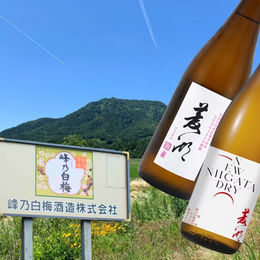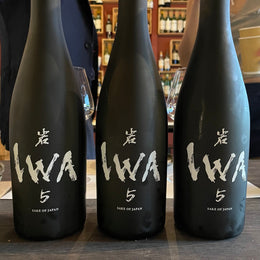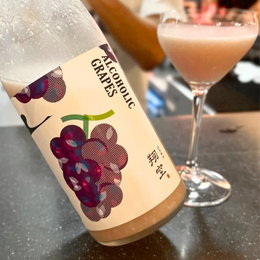Hana Tomoe Passion Wooden Barrel Storage Yamahai Junmai Sake, Miyoshino Brewery | 花巴 情熱 木桶仕込 木樽貯蔵 山廃純米酒 美吉野醸造
A wise man once said: A visionary, vision is scary. I feel like these are appropriate words when thinking of Sake Bar Yoramu's owner and operator, Yoram Offer.
On top of him owning one of the few sake bars in Japan, he's also probably the only one bottle aging his sake. But I won't go into that again as I've already talked about it in a previous review.

For me, another factor that makes him a visionary is him mentioning that he fears the momentum sake is gaining right now will weaken; and even lose popularity if majority of the producers continue to follow and make the light, delicate, clean and fruity style of sake that Dassai has made popular. Basically, due to the lack of variety.

Even though my exposure to sake is still minimal, I feel like I’ve explored enough of it to see how little explored the vast category is. Having started like most contemporary sake drinkers, I also once felt that all sake tasted the same. Because, prior to Sake Bar Yoramu, most of the ones I've had are fragile and have a similar profile to Dassai. What opened my eyes and made me more excited about the category is trying various sturdy wild fermented brands like Tamagawa and this one from Miyoshino.
The readily accessible sake brands going around these days are mostly fragile with delicate and light profiles. Fragile because the breweries encourage them to be drunk within a year of bottlings. If they don’t, the sake is expected to change to an unwanted profile. Whether it turns out better or worse, I’m not sure. Even the sake geeks I’ve spoken to say the brewers themselves aren’t sure. The fact is, the sake becomes different. Which can be a problem as it's not the same product the brewery wants to present. On the surface, this may encourage sales because distributors have to sell sell sell. But, coming from the perspective of wine and whisky collectors, I think it leaves out the segment of the market that wants to collect. Why collect a product if the belief is that the product isn’t worth keeping because it will end up being different which will make it lose value.

As someone who used to think that all white rum are similar to Bacardi's Carta Blanca, I can totally see where Yoram is coming from. I mean, for the longest time, white rum was only mainly seen as a light tasting mixter. Which only brought sales to a few brands but didn’t really help the category grow. It's trying white, funky and wild fermented sugarcane spirits like Hampden's Rum Fire from Jamaica and Haiti’s Clairin that really opened my eyes as to how diverse sugarcane spirits can be. After learning about these types of rum, I became more excited about it and let others try it; These others ended up becoming more interested in rum after learning of the variety rum has. I should note that there are also good funky and cultured yeast fermented white rum such as Wray & Nephew, Rum Bar Silver, Rum Bar Overproof and agricoles.
We all have a pretty good idea of the effects of having only one popular style. The category stagnates. With light white rum such as Bacardi and Havana Club ruling the market, people ended up thinking that's all the category has to offer. Even though the different regional styles of Scotch single malt is now considered flawed, we can’t deny that it gave Scotch more press. What happens if this trend continues in sake? It's safe to say that people will also lose interest. Because they think that everything will just taste the same despite having different stories.
The sake I’m reviewing today is a wild fermented Yamahai Junmai from Nara that’s been stored in cedar wood barre. Both the rice and koji are also from Nara. With the rice polishing at 70%. The brewery is called Miyoshino; This brand is called Hana Tomoe. Hana refers to flowers. I tried a different expression while at Yoramu.
Hana Tomoe Passion Wooden Barrel Storage Yamahai Junmai Sake – Review

17% abv. 720ml. JPY 2500.
Color: Melted Butter
On the nose: I get light but dry and long aromas of sandal wood, wood shavings, cedar, incense, Japanese temples, dried mango and tsukemono cucumber.
In the mouth: The wood notes are more intense here but shorter and less coherent. I get bold but delicate tastes of spice, cedar, overripe citrus peels, dried mango, incense and gherkins.
Conclusion: The flavors here are bolder than the typical sake. This is likely due to the wild fermentation and cedar barrel aging. But from what I know, the Japanese sake producers aren’t known to toast or char their cedar casks. So I’m curious if the cedar for this has been, at least, seasoned. I think fans of the white varieties of sherry will like this one.
Is it worth the price point? Hell yes. Considering this is a sturdy kind of sake you can enjoy or keep over a few months and maybe even years. Letting sake drinkers who have never tried something like this will surely shock them.
Score: No score. But delicious, interesting and different.
Lead image courtesy of John Go.
|
John is a cocktail and spirits enthusiast born and raised in Manila. His interest started with single malts in 2012, before he moved into rum and mezcal in search of malterntaitves – and a passion for travel then helped build his drinks collection. |







